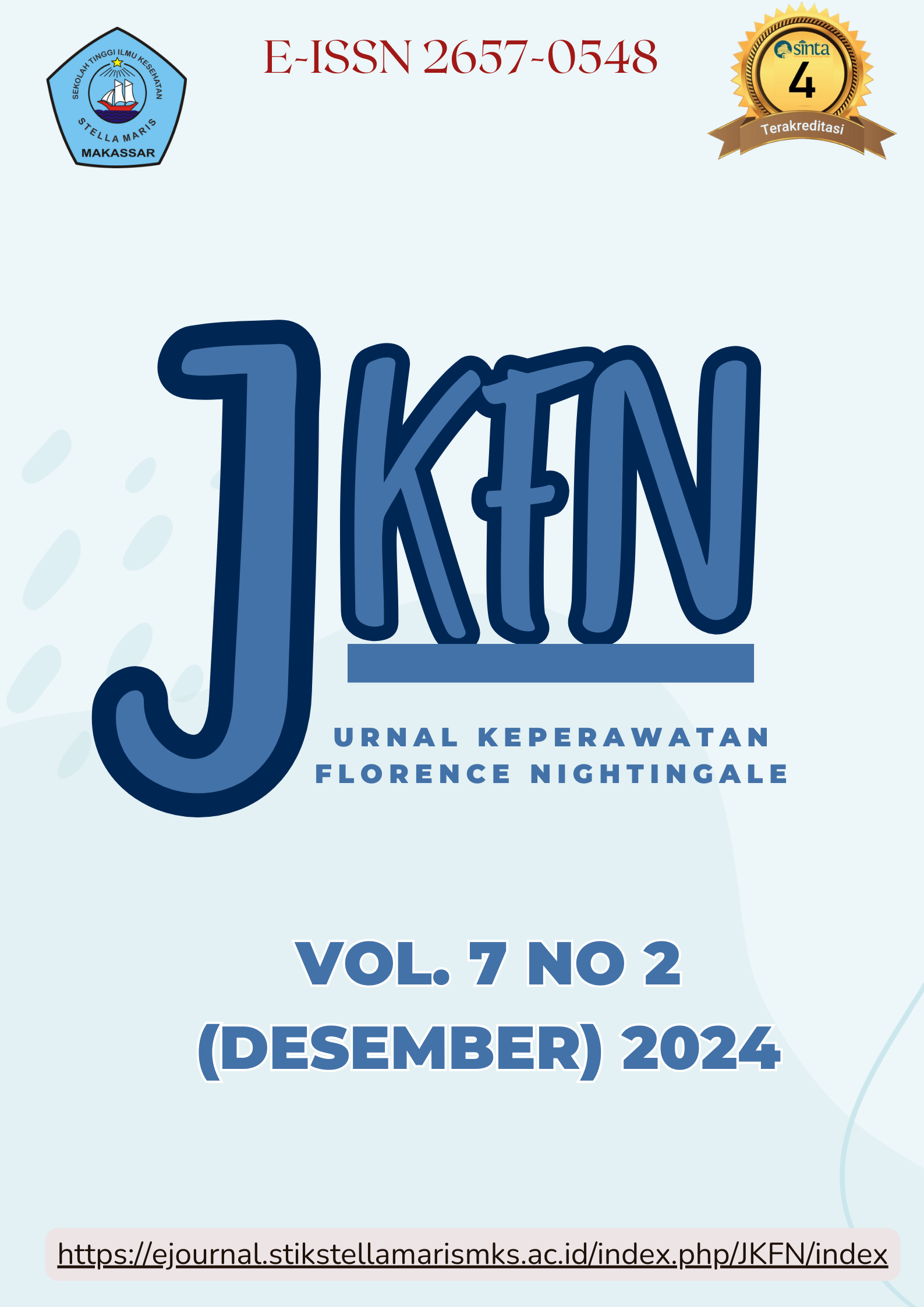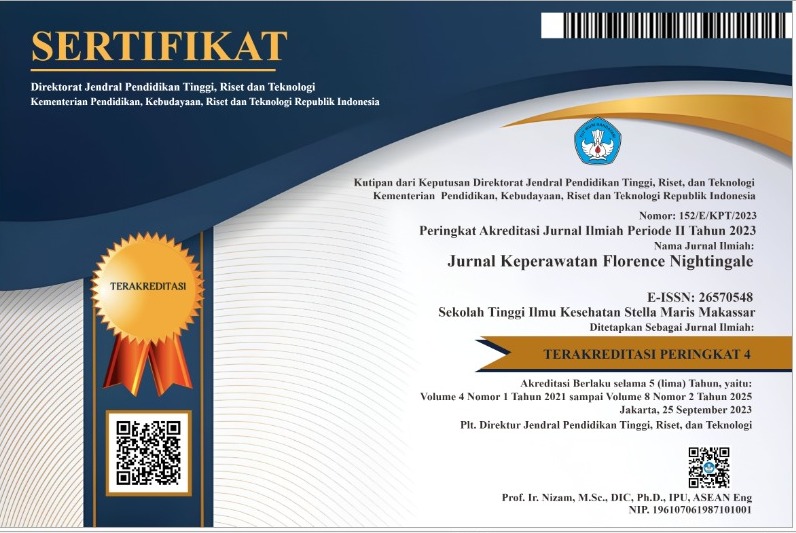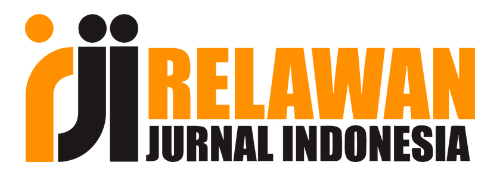The Effect of Buteyko Breathing Intervention on the Sleep Quality of Nursing Students
Keywords:
Buteyko breathing, Sleep Quality, Sleep Disturbances, Students, PSQIAbstract
Poor sleep quality is a common issue among students, negatively impacting their physical health, mental well-being, and academic performance. Buteyko breathing technique is a non-pharmacological method that has the potential to improve sleep quality by normalizing breathing patterns. This study aims to analyze the effect of Buteyko breathing technique on the sleep quality of students. The research employed a pre-experimental design with a one-group pretest-posttest approach, utilizing the Pittsburgh Sleep Quality Index (PSQI) as an instrument. The sample consisted of 30 final-year nursing students with sleep disturbances, selected through purposive sampling. The intervention involved level 1 Buteyko breathing exercises conducted twice daily, in the morning and evening, over one week. Sleep quality was measured using the PSQI, and data analysis was performed using paired t-tests. The results showed that the mean sleep quality score decreased from 13.07 (poor category) before the intervention to 8.47 after the intervention (p = 0.000). The most significant improvement was observed in the sleep duration component, with a mean reduction of 0.9 points. The Buteyko breathing technique effectively improved the students' sleep quality and can be considered a complementary therapy for addressing sleep disturbances to students.
Downloads
References
Acharya, R., Blackwell, S., Simoes, J., Harris, B., Booth, L., Bhangu, A., & Glasbey, J. (2024). Non-pharmacological interventions to improve sleep quality and quantity for hospitalized adult patients-co-produced study with surgical patient partners: systematic review. BJS Open, 8(2), 1–14. https://doi.org/10.1093/bjsopen/zrae018
Burgess, J., Ekanayake, B., Lowe, A., Dunt, D., Thien, F., & Dharmage, S. C. (2011). Systematic review of the effectiveness of breathing retraining in asthma management. Expert Review of Respiratory Medicine, 5(6), 789–807. https://doi.org/10.1586/ers.11.69
Buysse, D. J., III, C. F. R., Monk, T. H., Berman, S. R., & Kupfer, D. J. (1988). The Pittsburgh Sleep Quality Index: A New Instrument for Psychiatric Practice and Research. In Biochemical and Biophysical Research Communications (pp. 193–213). https://doi.org/10.1006/bbrc.2001.6263
Course, A. B. (n.d.). Buteyko-Course-Manual.
Courtney, R. (2020). Breathing retraining in sleep apnoea: a review of approaches and potential mechanisms. Sleep & Breathing = Schlaf & Atmung, 24(4), 1315–1325. https://doi.org/10.1007/s11325-020-02013-4
Dahlan, S. (2013). Statistik untuk kedokteran dan kesehatan (6th ed.). Epidemiologi Indonesia.
Dal Molin, L. (2015). Using the SUDS Scale to Measure the Intensity of Feelings. Inneractions Psychology and Psichotherapy, 8–10.
De Moraes, A. C. F., Conceição da Silva, L. C., Lima, B. S., Marin, K. A., Hunt, E. T., & Nascimento-Ferreira, M. V. (2024). Reliability and validity of the online Pittsburgh sleep quality index in college students from low-income regions. Frontiers in Digital Health, 6(July), 1–6. https://doi.org/10.3389/fdgth.2024.1394901
Dijk, D. J., & Czeisler, C. A. (1995). Contribution of the circadian pacemaker and the sleep homeostat to sleep propensity, sleep structure, electroencephalographic slow waves, and sleep spindle activity in humans. Journal of Neuroscience, 15(5 I), 3526–3538. https://doi.org/10.1523/jneurosci.15-05-03526.1995
Gaultney, J. F. (2010). The prevalence of sleep disorders in college students: Impact on academic performance. Journal of American College Health, 59(2), 91–97. https://doi.org/10.1080/07448481.2010.483708
Gunarsa, S. D., & Wibowo, S. (2021). Hubungan Kualitas Tidur Dengan Kebugaran Jasmani Siswa. Jurnal Pendidikan Jasmani, 09(01), 43–52.
H. Subramanian, V., Kumar Sah, B., & Kumar. A.K, V. K. (2023). Effect of Buteyko Breathing Technique on Stress in Physiotherapy Students. International Journal of Science and Healthcare Research, 8(1), 220–224. https://doi.org/10.52403/ijshr.20230131
Holloway, E. A., & West, R. J. (2007). Integrated breathing and relaxation training (the Papworth method) for adults with asthma in primary care: A randomised controlled trial. Thorax, 62(12), 1039–1042. https://doi.org/10.1136/thx.2006.076430
Jain, M., Vardhan, V., Yadav, V., & Harjpal, P. (2021). Efficacy of Buteyko Breathing Technique on Anxiety, Depression, and Self-efficacy in Coronary Artery Bypass Graft Surgery Patients: A Protocol for Randomized Clinical Trial. Journal of Pharmaceutical Research International, 107–114. https://doi.org/10.9734/jpri/2021/v33i51a33473
Keenan, S. A., Hirshkowitz, M., & Casseres, H. (2013). Monitoring and Staging Human Sleep. Encyclopedia of Sleep, V2-71-V2-79. https://doi.org/10.1016/B978-0-12-378610-4.00138-8
Keswara, U. R., Syuhada, N., & Wahyudi, W. T. (2019). Perilaku penggunaan gadget dengan kualitas tidur pada remaja. Holistik Jurnal Kesehatan, 13(3), 233–239. https://doi.org/10.33024/hjk.v13i3.1599
Kumar, S., Samal, A., & Dwivedi, S. (2023). Sleep Quality, Daytime Sleepiness and Mental Health in Undergraduate Medical Students: A Cross-sectional Descriptive Study. Journal of Clinical and Diagnostic Research, 3–7. https://doi.org/10.7860/jcdr/2023/60633.17524
Liu, X., Lang, L., Wang, R., Chen, W., Ren, X., Lin, Y., Chen, G., Pan, C., Zhao, W., Li, T., Han, C., He, L., & Gu, Y. (2021). Poor sleep quality and its related risk factors among university students. Annals of Palliative Medicine, 10(4), 4479–4485. https://doi.org/10.21037/apm-21-472
Lund, H. G., Reider, B. D., Whiting, A. B., & Prichard, J. R. (2010). Sleep Patterns and Predictors of Disturbed Sleep in a Large Population of College Students. Journal of Adolescent Health, 46(2), 124–132. https://doi.org/10.1016/j.jadohealth.2009.06.016
Mavkar, S. S., & Shukla, M. P. (2024). Effect of Buteyko Breathing Technique as an Adjunct to Routine Physiotherapy on Pulmonary Functions in Patients Undergoing Off-pump Coronary Artery Bypass Surgery: A Randomized Controlled Trial. Indian Journal of Critical Care Medicine, 28(3), 280–285. https://doi.org/10.5005/jp-journals-10071-24655
Pace-Schott, E. F., & Hobson, J. A. (2002). The neurobiology of sleep: Genetics, cellular physiology and subcortical networks. Nature Reviews Neuroscience, 3(8), 591–605. https://doi.org/10.1038/nrn895
Panwar, J., & Durangi, P. (2024). Effectiveness of Buteyko Breathing Technique in Post-COVID Adult Patients - An Experimental Study. 8(September), 67–71.
Seetharamaraju, V., Sherikar, R., Bhansali, S. C., & Chandra, T. J. (2023). Comparative Study on Buteyko Breathing Technique and Pranayama on Pulmonary Function and Quality of Life in COPD Individuals. International Journal of Pharmaceutical and Clinical Research, 15(2), 376–379. https://www.embase.com/search/results?subaction=viewrecord&id=L2022733355&from=export
Setyowati, A., & Chung, M. H. (2021). Validity and reliability of the Indonesian version of the Pittsburgh Sleep Quality Index in adolescents. International Journal of Nursing Practice, 27(5), 1–7. https://doi.org/10.1111/ijn.12856
Stores, R., Linceviciute, S., Pilkington, K., & Ridge, D. (2023). Sleep disturbance, mental health, wellbeing and educational impact in UK university students: a mixed methods study. Journal of Further and Higher Education, 47(8), 995–1008. https://doi.org/10.1080/0309877X.2023.2209777
Published
How to Cite
Issue
Section
Copyright (c) 2025 Imam Abidin, Lia Nurlianawati, Santi Puspitasari

This work is licensed under a Creative Commons Attribution-ShareAlike 4.0 International License.









